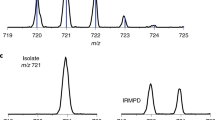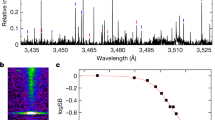Abstract
Diffuse interstellar bands (DIBs) are mysterious absorption lines in the optical spectra of stars, and have been known for 75 years1. Although it is widely believed2,3,4 that they arise from gas-phase organic molecules (rather than from dust grains) in the interstellar medium, no consensus has been reached regarding their precise cause. The realization that many emission features in astronomical infrared spectra probably arise from polycyclic aromatic hydrocarbons5,6,7,8 (PAHs), which may themselves be very abundant in the interstellar medium, has led to the suggestion that ionized PAHs might be the source of the DIBs9,10,11,12. Laboratory investigations have revealed that small, positively charged PAHs in matrices have absorption features that bear some resemblance to DIBs13,14,15, but no clear identification of any DIB with any specific PAH cation has yet been made. Here we report a laboratory study of the chemical reactivity of PAH cations (C6H6+, C10H8+and C16H10+) in the gas phase. We find that these PAH cations are very reactive, and are therefore unlikely to survive in high abundances in the interstellar medium. Rather, such molecules will react rapidly with hydrogen, and we therefore suggest that the resulting protonated PAH cations (and species derived from them) should become the focus of future searches for a correspondence between molecular absorption features and the DIBs.
This is a preview of subscription content, access via your institution
Access options
Subscribe to this journal
Receive 51 print issues and online access
$199.00 per year
only $3.90 per issue
Buy this article
- Purchase on Springer Link
- Instant access to full article PDF
Prices may be subject to local taxes which are calculated during checkout
Similar content being viewed by others
References
Heger, M. L. The spectra of certain class B stars in the regions 5630 å–6680 å and 3280 å–3380 å. Lick Obs. Bull. 10, 146–147 (1922).
Tielens, A. G. G. M. & Snow, T. P. (eds) The Diffuse Interstellar Bands (Kluwer, Dordrecht, (1995)).
Herbig, G. H. The diffuse interstellar bands. Annu. Rev. Astron. Astrophys. 33, 19–73 (1995).
Snow, T. P. in From Stardust to Planetesimals (eds Pendleton, Y. J. & Tielens, A. G. G. M.) 147–157 (Astron. Soc. Pacific, San Francisco, (1997)).
Léger, A. & Puget, J. Identification of the “unidentified” IR emission features of interstellar dust? Astron. Astrophys. 137, L5–L8 (1984).
Allamandola, L. J., Tielens, A. G. G. M. & Barker, J. R. Polycyclic aromatic hydrocarbons and the unidentified infrared emission bands: auto exhaust along the Milky Way! Astrophys. J. 290, L25–L28 (1985).
Puget, J. & Léger, A. Anew component of the interstellar matter: small grains and large aromatic molecules. Annu. Rev. Astron. Astrophys. 27, 161–198 (1989).
Allamandola, L. J., Tielens, A. G. G. M. & Barker, J. R. Interstellar polycyclic aromatic hydrocarbons: the infrared emission bands, the excitation/emission mechanism, and the astrophysical implications. Astrophys. J. Suppl. 71, 733–775 (1989).
Crawford, M. K., Tielens, A. G. G. M. & Allamandola, L. J. Ionized polycyclic aromatic hydrocarbons and the diffuse interstellar bands. Astrophys. J. 293, L45–L48 (1985).
Léger, A. & d'Hendecourt, L. Are polycyclic aromatic hydrocarbons the carriers of the diffuse interstellar bands in the visible? Astron. Astrophys. 146, 81–85 (1985).
van der Zwet, G. P. & Allamandola, L. J. Polycyclic aromatic hydrocarbons and the diffuse interstellar bands. Astron. Astrophys. 146, 76–80 (1985).
Salama, F., Bakes, E. L. O., Allamandola, L. J. & Tielens, A. G. G. M. Assessment of the polycyclic aromatic hydrocarbon — Diffuse interstellar band proposal. Astrophys. J. 458, 621–636 (1996).
Salama, F. & Allamandola, L. J. The ultraviolet and visible spectrum of the polycyclic aromatic hydrocarbon C10H8+: Possible contributions to the diffuse interstellar bands and to the ultraviolet–visible extinction. Astrophys. J. 395, 301–306 (1992).
Salama, F. & Allamandola, L. J. Is a pyrene-like molecular ion the cause of the 4430 å diffuse interstellar absorption band? Nature 358, 42–43 (1992).
Léger, A., d'Hendecourt, L. & Défourneau, D. Proposed identification for the (common) carriers of the 4430 å and 7565 å DIBs. Astron. Astrophys. 293, L53 (1995).
Van Doren, J. M., Barlow, S. E., DePuy, C. H. & Bierbaum, V. M. The tandem flowing-afterglow-SIFT-drift. Int. J. Mass Spectrom. Ion Processes 81, 85–100 (1987).
Howorka, F. Reactions of singly and doubly charged argon ions with N2and O2in a steady state hollow cathode discharge. J. Chem. Phys. 68, 804–811 (1978).
Savage, B. D. & Sembach, K. R. Interstellar abundances from absorption-line observations with the Hubble Space Telescope. Annu. Rev. Astron. Astrophys. 34, 279–329 (1996).
Petrie, S., Javahery, G. & Bohme, D. K. Gas-phase reactions of benzenoid hydrocarbons and ions with hydrogen atoms and molecules: Uncommon constraints to reactivity. J. Am. Chem. Soc. 114, 9205–9206 (1992).
Scott, G. B. I. et al. CmHn+ reactions with H and H2: An experimental study. J. Phys. Chem. 101, 4973–4978 (1997).
Tosi, P. et al. The reaction of CO2+ with atomic hydrogen. J. Chem. Phys. 80, 1905–1906 (1984).
Setser, D. W. (ed.) Reactive Intermediates in the Gas Phase (Academic, New York, (1979)).
de Petris, G., Occhiucci, G. & Pepi, F. Amass spectrometric study of gaseous H4PO3+ and H2PO3− ions. Int. J. Mass Spectrom. Ion Processes 136, 155–166 (1994).
Giles, K., Adams, N. G. & Smith, D. Astudy of reactions of CnHm+ ions (n = 4,5,6; m = 0–6) with H2and CO at 300 K and 80 K. Int. J. Mass Spectrom. Ion Processes 89, 303–317 (1989).
Le Page, V., Keheyan, Y., Bierbaum, V. M. & Snow, T. P. Chemical constraints on organic cations in the interstellar medium. J. Am. Chem. Soc. 119, 8373–8374 (1997).
Snow, T. P. & Witt, A. N. The interstellar carbon budget and the role of carbon in dust and large molecules. Science 270, 1455–1460 (1995).
Abouelaziz, H., Gomet, J. C., Pasquerault, D. & Rowe, B. R. Measurements of C3H3+, C5H3+, C6H6+, C7H5+, and C10H8+ dissociative recombination rate coefficients. J. Chem. Phys. 99, 237–243 (1993).
Adamson, A. J., Whittet, D. C. B. & Duley, W. W. Diffuse interstellar bands in the Taurus dark clouds. Mon. Not. R. Astron. Soc. 252, 234–245 (1991).
Snow, T. P., Bakes, E. L. O., Buss, R. H. & Seab, C. G. The weakness of diffuse bands in nebular environments: Possible impact on the PAH+ hypothesis. Astron. Astrophys. 296, L37–L40 (1995).
Le Page, V., Bierbaum, V. M., Keheyan, Y. & Snow, T. P. Astudy of reactions of cations derived from naphthalene with molecules and atoms of interstellar interest. J. Am. Chem. Soc.(submitted).
Allain, T., Leach, S. & Sedlmayr, E. Photodestruction of PAHs in the interstellar medium. I. Photodissociation rates for the loss of an acetylenic group. Astron. Astrophys. 305, 602–615 (1996).
Omont, A. Astron. Astrophys. 164, 159–178 (1986).
Acknowledgements
This research has been supported by a NASA grant to the University of Colorado.
Author information
Authors and Affiliations
Corresponding author
Rights and permissions
About this article
Cite this article
Snow, T., Le Page, V., Keheyan, Y. et al. The interstellar chemistry of PAH cations. Nature 391, 259–260 (1998). https://doi.org/10.1038/34602
Received:
Accepted:
Issue Date:
DOI: https://doi.org/10.1038/34602
This article is cited by
-
Efficient stabilization of cyanonaphthalene by fast radiative cooling and implications for the resilience of small PAHs in interstellar clouds
Nature Communications (2023)
-
Low-temperature nitrogen-bearing polycyclic aromatic hydrocarbon formation routes validated by infrared spectroscopy
Nature Astronomy (2022)
-
Growth of rare gases on coronene
Theoretical Chemistry Accounts (2021)
-
Time-resolved relaxation and fragmentation of polycyclic aromatic hydrocarbons investigated in the ultrafast XUV-IR regime
Nature Communications (2021)
-
Simulation of vibrationally resolved absorption spectra of neutral and cationic polyaromatic hydrocarbons
Theoretical Chemistry Accounts (2020)
Comments
By submitting a comment you agree to abide by our Terms and Community Guidelines. If you find something abusive or that does not comply with our terms or guidelines please flag it as inappropriate.



